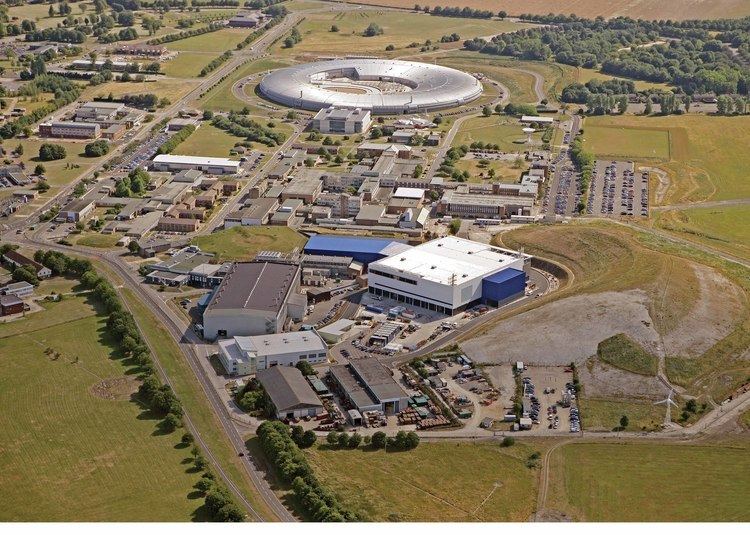Established 1957 (1957) Staff 1200 | ||
 | ||
Laboratory type National scientific research laboratory Field of research Applied scienceFundamental science Operating agency Website www.stfc.ac.uk/about-us/rutherford-appleton-laboratory/ | ||
The rutherford appleton laboratory apprenticeship scheme
The Rutherford Appleton Laboratory (RAL) is one of the national scientific research laboratories in the UK operated by the Science and Technology Facilities Council (STFC). It is located on the Harwell Science and Innovation Campus at Chilton near Didcot in Oxfordshire, United Kingdom. It has a staff of approximately 1,200 people who support the work of over 10,000 scientists and engineers, chiefly from the university research community. The laboratory's programme is designed to deliver trained manpower and economic growth for the UK as the result of achievements in science.
Contents
- The rutherford appleton laboratory apprenticeship scheme
- Visiting vulcan the petawatt laser system at the rutherford appleton laboratory
- History
- Facilities
- Programmes
- Economic impact
- In popular culture
- References
Visiting vulcan the petawatt laser system at the rutherford appleton laboratory
History
RAL is named after the physicists Ernest Rutherford and Edward Appleton.
The National Institute for Research in Nuclear Science (NIRNS) was formed in 1957 to operate the Rutherford High Energy Laboratory established next to the Atomic Energy Research Establishment on the former RAF Harwell airfield between Chilton and Harwell. The 50 MeV proton linear accelerator was transferred from the Atomic Energy Research Establishment to the new laboratory to become a national facility for particle physics as the Nimrod (synchrotron). Some components of this linear accelerator are still operating as part of the ISIS injector linac over 50 years after their first use. Since then the laboratory has grown both with the expansion of its established facilities, and the incorporation of facilities from other institutions to provide the benefits from economies of scale. The major mergers were in 1975 with the adjacent Atlas Computer Laboratory creating the Rutherford Laboratory, and then in 1979 with the Appleton Laboratory to form the current Rutherford Appleton Laboratory. With the closure of the Royal Greenwich Observatory in 1998, some small offices also moved to RAL. Similarly, laser technology moved to RAL from Joint European Torus at Culham to become the foundation of the Central Laser Facility.
In order to be able to decide the priorities for government funding across all areas of scientific research, the Science & Technology Act of 1965 created the Science Research Council (SRC) which took over management of the Rutherford High Energy Laboratory from NIRNS along with many other previously disparate UK science bodies. In order to prioritise economic impact over blue skies research, the SRC became the Science and Engineering Research Council (SERC) in the early 1980s, and in 1994, the SERC was eventually divided into three Research Councils (the EPSRC, PPARC and the CCLRC — which took responsibility for RAL from EPSRC in 1995), so that each could then focus its development around one of three incompatible business models — administratively efficient short duration grant distribution, medium term commitments to international agreements, long term commitments to staff and facilities provision. In order to unify the planning of the provision for UK scientists to access large national and international facilities, in 2007 the CCLRC merged with PPARC and incorporated the nuclear physics discipline from EPSRC to create the Science and Technology Facilities Council which then took responsibility for RAL.
Facilities
RAL hosts two of the UK's major scientific facilities:
ISIS is a spallation neutron source. The neutrons it produces are mainly used in neutron scattering experiments to study the atomic structure and dynamics of materials. ISIS provides research capabilities for around 1600 scientists from a range of disciplines, and has been operating since 1985. ISIS evolved from the original Nimrod proton synchrotron, whose location is currently used for the synchrotron which generates the neutrons and muons used to study materials in ISIS.
The Central Laser Facility provides access to large scale laser systems for researchers from the United Kingdom and other EU countries. The facility operates high power glass and Ti:Sapphire laser installations(including the Vulcan and Astra lasers) and a number of smaller scale, tuneable lasers. A vigorous development programme ensures that facilities maintain their international competitiveness.
A third major facility is sited next to RAL and mostly owned by the STFC, sharing campus infrastructure:
The Harwell Science and Innovation Campus was controversially chosen over the Daresbury Science and Innovation Campus as the site for the synchrotron light source Diamond, which officially opened in January 2007.
RAL also hosts several minor facilities, including:
RAL hosts a number of other resources and services in microelectronics, atmospheric sciences, spectroscopy and renewable energy research.
Programmes
In addition to hosting facilities for the UK, RAL also operates departments to co-ordinate the UK programme of participation in major international facilities. The largest of these are the areas of particle physics, and space science.
In particle physics the largest international project is the Large Hadron Collider at CERN, but RAL has a major role in the UK participation in several other projects such as:
In space science, RAL builds components for, and tests satellites, as well as receiving, analysing and curating the data collected by those spacecraft. Satellite missions in which RAL has a significant role include:
Economic impact
In recent years, there has been an increasing political drive towards requiring that the science undertaken at RAL and the technology created there result in a proportional economic benefit to the UK in order to justify the investment of public funds in the laboratory. RAL management have argued that this is achieved in various ways, including:
In popular culture
RAL was used as a set for the filming of an episode of Terry Nation's BBC TV series Blake's 7.
The computer-generated imagery (CGI) for Ridley Scott's 1979 film Alien were created at the Atlas Computer Laboratory which is now part of RAL.
The Space Science department featured in the "In the Box" episode of the CBeebies series Nina and the Neurons.
